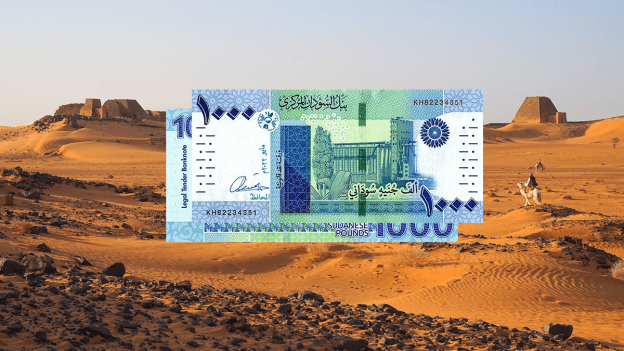Sudan is a country in the heart of Africa. It is the largest country in Africa. It’s bordered by Egypt in the north, South Sudan, Ethiopia and Eritrea to the east. In addition to Chad, and the Central African Republic to the west. Sudan has had a very rich history that began thousands of years ago. Over the centuries many different people who inhabited the area have been able to live together peacefully. Read along to learn some history on Sudan and their newly released banknote.
Early History of Sudan
Sudan has been occupied by many different civilizations throughout its history. The Nile River Valley is considered one of the cradles of civilization, as some of the earliest human settlements were found there. During this time, it was part of Egypt’s kingdom and later became known as Nubia. It was a powerful civilization. Nubia was influenced by various countries; however they were able to keep their culture intact through all these invasions because they had already established themselves as a powerful force before all these other regions started conquering them.
The Mahdist state arose out of a jihadi uprising in 1881-1885 against Egyptian and Turkish domination. The movement was led by Muhammad Ahmad bin Abd Allah (c. 1830-1885), who had claimed that he was the Mahdi, or messiah, from whom the Muslims would receive salvation. The Sudanese struggled for years in battle and suffered a significant blow from Egypt and Britain on September 2, 1898 at the Battle of Omdurman.
Battle for Independence
The next year, 1899, Anglo-Egyptian forces dealt a decisive blow to the remaining Mahdist Army at the Battle of Umm Diwaykarat. The invading forces were led by Lord Herbert Kitchener (1850-1916). Around this time Kitchener had developed a reputation for his cold and pushy personality. This battle resulted in the death of Abdallahi ibn Muhammad, the last remaining leader. Sudan had officially fallen to the British and it would be decades before breaking free. In 1956, Sudan became independent with Egypt remaining its own nation.
Sudan has had many ups and downs during its existence as an independent state but it has also always managed to overcome them. Today Sudan still faces many challenges but nevertheless it continues moving forward towards the future with hope
New Sudan 1,000 Pound Banknote
Earlier this year the Central Bank of Sudan released a new 1,000 Pound banknote addition to the current series. This is due to rising inflation which the country is currently facing along with the rest of the world. The Sudanese Pound has significantly decreased in value over the last few years and it has had led to major economic devastation in the country. On the obverse of the blue and yellow banknote are a Sorghum plant and also grain silos. The reverse depicts a Sorghum plant and farmers plowing a field with cattle and with a waterfall in the background. The note’s watermark reveals a Secretary bird and an electrotype CBOS / LS 1000. It also has a RAPID windowed security thread with Islamic ornaments.
Sources:
https://en.wikipedia.org/wiki/Sudan
https://www.britannica.com/place/Sudan
